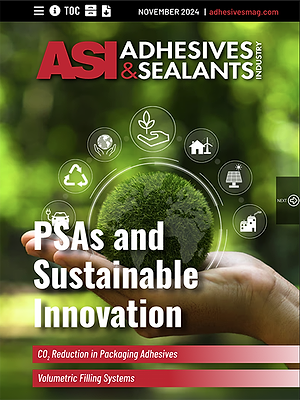Home » Publications » Adhesives & Sealants Industry
Adhesives & Sealants Industry

November 2024
Features
Back to TopFrom smartphones and automotive displays to wearable devices and medical equipment, businesses and consumers alike are continuing to lean into complex electronics.
Read More
The Key to Success in Volumetric Filling Systems
How volumetric filling systems help to achieve precise repeatability at high operational velocities.
November 13, 2024
A New Tool to Reduce the Carbon Footprint of Packaging Adhesives
ASI talked to Vernon Jansen van Rensburg, Head of Global Market Development for Sasol’s Wax business, to discuss SASOLWAX LC100 and how it can help adhesive manufacturers reduce their carbon footprint and reach their sustainability goals.
November 13, 2024
Research Challenges Conventional Thought on Wet-Surface Adhesion
The implications of this research are significant, particularly in biomedical applications such as bandages, health monitoring sensors for moist skin, and advanced adhesives that could replace sutures.
November 15, 2024
Unlocking the Full Potential of Sustainable Two-Component Packaging
Filling may seem like a straightforward step in the packaging process, but it is fraught with challenges that can lead to issues like leakage, poor application, and poor mixing quality.
November 19, 2024
Adhesive Technology Trends Driving Packaging Innovation
Although adhesive traditionally has created one of the biggest hurdles to effective recycling, recent innovations offer new opportunities.
November 25, 2024
Columns
Back to TopHow Adhesive Tapes Support the Clean-Energy Transition
The renewable energy sector is gearing up to expand capacity to meet the ambitious target set by Europe’s Renewable Energy Directive.
November 26, 2024
Keep the info flowing with our eNewsletters!
Get the latest industry updates tailored your way.
JOIN TODAY!Copyright ©2024. All Rights Reserved BNP Media.
Design, CMS, Hosting & Web Development :: ePublishing








